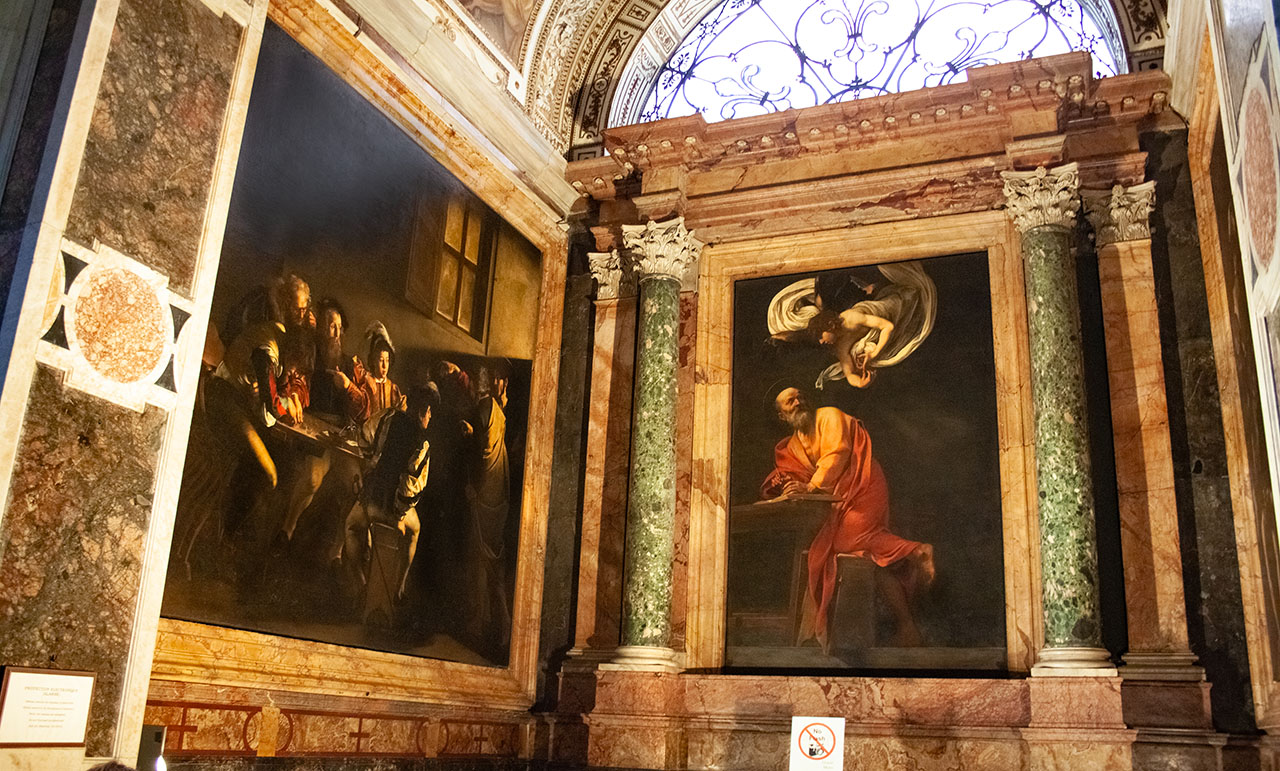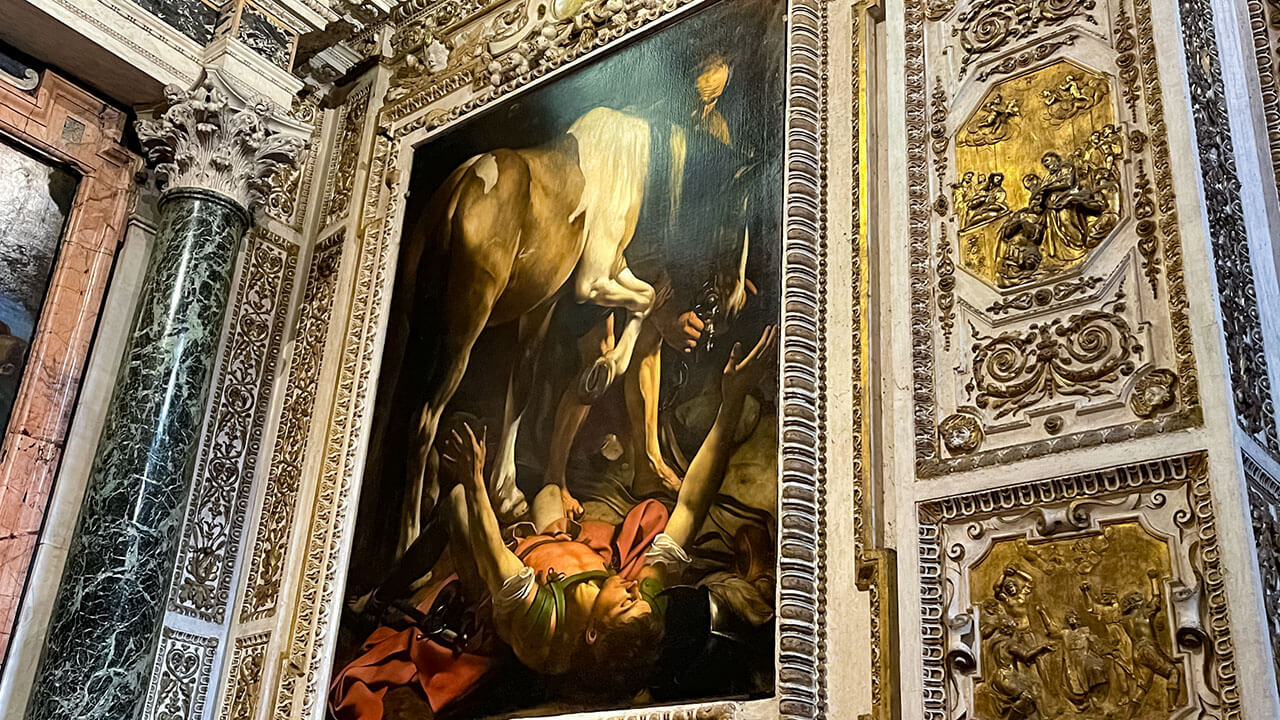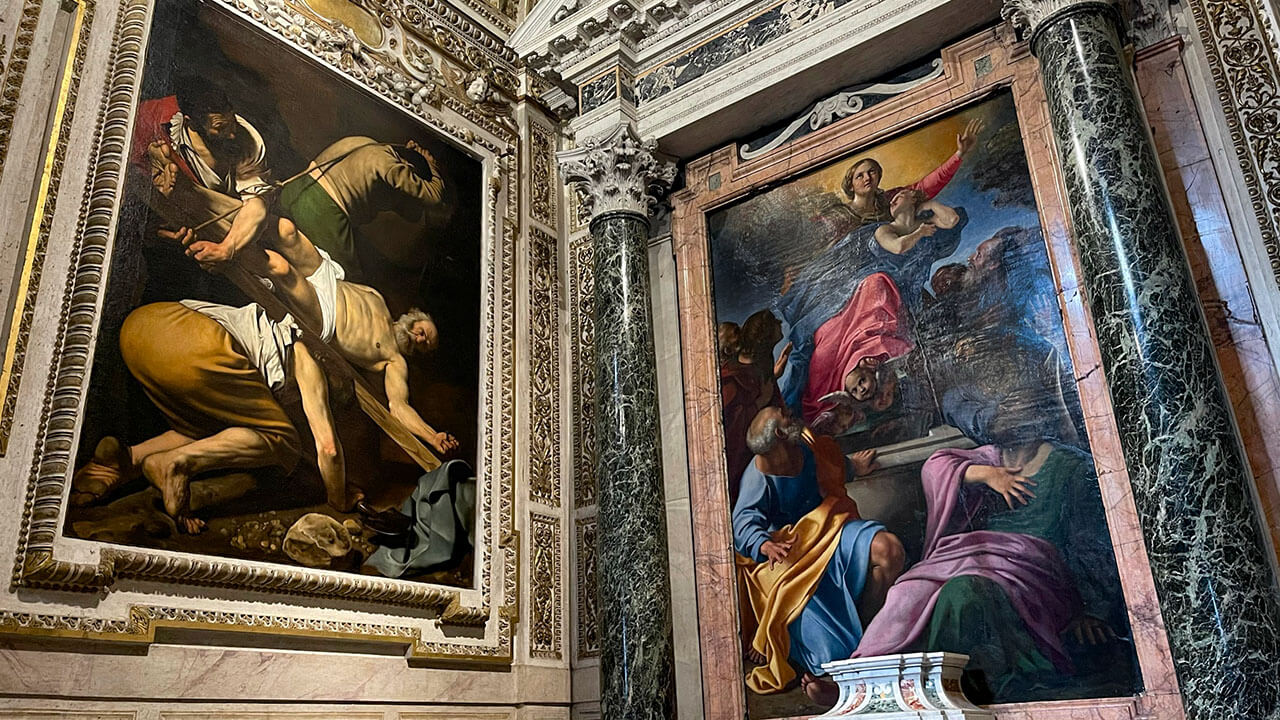Beyond Museums: Where to see Caravaggio Paintings in Rome, Italy

Buongiorno and welcome to Stefano Rome Tours, Rome’s premier tour company for Shore Excursions from Civitavecchia, private Italy sightseeing tours from Rome, and long-distance transfers in Italy. If you are wondering where to see Caravaggio paintings in Rome, Italy without having to go to museums, this blog will guide you specifically to those showcasing Caravaggio's masterpieces beyond museums (and free of charge!).
Rome, a city steeped in history and art, is home to the captivating works of the Baroque master Caravaggio. While numerous must-see churches in Rome house priceless artistic treasures, three churches in Rome host masterpiece paintings by Caravaggio.
Who is Caravaggio?
Michelangelo Merisi da Caravaggio, known mononymously as Caravaggio, is hailed as one of the most influential painters of the Baroque era. Born in 1571 in Milan, Italy, Caravaggio's groundbreaking artistic style and revolutionary use of light and shadow have left an indelible mark on the art world.

Caravaggio, an acclaimed Italian artist, revolutionized the art world with his groundbreaking technique known as chiaroscuro, which he masterfully combined with tenebrism. Chiaroscuro involves the skillful use of light and dark contrasts to create depth and drama in paintings. Caravaggio elevated this technique to new heights, employing dramatic contrasts to transfix subjects in vivid shafts of light while plunging surrounding areas into deep shadows.
Renowned for his rapid, direct approach to painting, Caravaggio often bypassed traditional methods of sketching, opting instead to work directly onto the canvas with live models. This spontaneous process allowed him to capture crucial moments and scenes with remarkable realism and emotional intensity.
Caravaggio's art frequently depicted powerful narratives, often revolving around themes of violence, struggle, and mortality. His works pulsate with raw emotion, drawing viewers into the heart of the action and inviting contemplation on the human condition.
The impact of Caravaggio's innovative style was profound, giving rise to the Baroque movement and influencing a generation of artists, including luminaries such as Peter Paul Rubens, Gian Lorenzo Bernini, and Rembrandt. Artists inspired by Caravaggio's bold use of chiaroscuro and tenebrism were termed "Caravaggisti" or "shadowists", a testament to his enduring influence on the art world.
Beyond Museums:
Where to see Caravaggio Paintings in Rome
In the heart of Rome, where history and art converge, museums and churches serve as galleries showcasing Caravaggio's unparalleled genius.
This blog invites you to delve into the fascinating world of Caravaggio, exploring why his paintings are not only revered but considered essential must-see works for anyone seeking to grasp the soul-stirring beauty of Baroque art in its purest form. Better yet, you can see these paintings in some of the most fascinating must-see churches in Rome!
San Luigi dei Francesi - St Matthew Caravaggio Paintings
San Luigi dei Francesi, a magnificent church located just a stone's throw away from Piazza Navona, stands as a testament to the rich artistic and cultural heritage that Rome possesses. Constructed in the late 16th century, this church has not only served as a place of worship but has also become a shrine to some of Caravaggio's most renowned masterpieces.
The highlight of San Luigi dei Francesi is undeniably the Contarelli Chapel, an architectural gem within the church that holds three of Caravaggio's iconic paintings, making it an absolute must-visit for enthusiasts of the Baroque master.
"The Calling of Saint Matthew": This masterpiece, adorning the walls of the Contarelli Chapel, captures a pivotal moment in the life of Saint Matthew. Caravaggio's use of chiaroscuro, the dramatic interplay of light and shadow, takes center stage as he skillfully illuminates the figures within the painting. The play of light not only directs attention to the divine intervention but also enhances the emotional intensity of the scene.

"The Inspiration of Saint Matthew": Adjacent to "The Calling," this painting continues the narrative with Saint Matthew receiving divine inspiration. Caravaggio's ability to depict emotion with startling realism is on full display, as Saint Matthew, accompanied by an angel, is inspired to write the Gospel. The details and nuanced expressions in the painting draw viewers into the sacred moment.
"The Martyrdom of Saint Matthew": Concluding the trilogy, this intense and poignant depiction of Saint Matthew's martyrdom showcases Caravaggio's mastery of the dramatic. The use of light in this painting is particularly striking, accentuating the brutal reality of the scene. The contrast between the dark background and the illuminated figures creates a powerful visual impact, underscoring the solemnity of the subject matter.

Visitors to San Luigi dei Francesi have the opportunity not only to witness these masterpieces but also to immerse themselves in the historical and spiritual ambiance of the church. The Contarelli Chapel, a remarkable fusion of art and architecture, serves as a shrine to Caravaggio's genius, inviting visitors to contemplate the profound narratives conveyed through each brushstroke.
Church of Sant'Agostino - Madonna of Loreto
Located in the district of Campo Marzio also near Piazza Navona, the church of Sant'Agostino stands as a timeless testament to both spiritual devotion and artistic brilliance. Originally built in the 13th century, the church underwent several renovations, with its present appearance reflecting a harmonious blend of Renaissance and Baroque influences.
One of the most treasured gems within Sant'Agostino is the awe-inspiring painting by Caravaggio known as the "Madonna of Loreto" or "Pilgrims' Madonna". This masterpiece is housed in the Cavalletti Chapel, capturing the attention and admiration of visitors with its emotive power and masterful use of light.

"Madonna of Loreto" is an intimate portrayal of the Virgin Mary and the Christ Child. The scene is poignant yet tender, depicting the Virgin Mary holding the infant Jesus in a modest and touching embrace. Caravaggio's ability to infuse the scene with a profound emotional resonance is evident in the gentle gaze exchanged between mother and child.
What sets this painting apart is Caravaggio's groundbreaking use of light. The heavenly atmosphere is crafted through the innovative play of light, which seems to emanate from an unseen source, enveloping the figures in a warm and divine glow. The contrast between the softly illuminated faces and the darker background draws the viewer's gaze toward the central figures, creating a sense of intimacy and reverence.
As visitors stand before the "Madonna of Loreto" in Sant'Agostino, they are transported into a moment of profound serenity and spirituality. The Cavalletti Chapel itself, with its architectural elegance, provides a fitting backdrop for Caravaggio's masterpiece. The combination of the painting and the sacred space in which it resides offers a unique and immersive experience for art enthusiasts and pilgrims alike.
Beyond the artistic splendor, Sant'Agostino invites visitors to explore its rich history and architectural details. The church's chapels, adorned with notable artworks and sculptures, contribute to the overall grandeur of the space. Sant'Agostino, with its Caravaggio masterpiece, remains a hidden gem in Rome, beckoning those seeking not only artistic marvels but also a profound connection to the divine through the transformative power of Caravaggio's brush.
Basilica of Santa Maria del Popolo - 2 Caravaggio Masterpieces
Nestled in the heart of Rome, the Basilica of Santa Maria del Popolo stands as an architectural marvel, its history intertwining with the city's cultural evolution. Originally founded in the 11th century, the church underwent various renovations over the centuries, with its current Renaissance appearance owing much to Bramante and Raphael.

However, what draws art enthusiasts and Caravaggio aficionados alike to Santa Maria del Popolo is the captivating Cerasi Chapel, a sanctuary within the basilica that houses two of Caravaggio's masterpieces, creating an unparalleled visual spectacle.
"Conversion on the Way to Damascus": The first of Caravaggio's works within the Cerasi Chapel, this painting depicts the dramatic moment when Saul, later known as Saint Paul, experiences a profound spiritual conversion. Caravaggio's unparalleled ability to capture human emotion is evident in the intense expression on Saint Paul's face, bathed in the divine light that permeates the scene.
The play of light and shadow contributes to the overall realism, drawing visitors into the transformative narrative.

"Crucifixion of Saint Peter": Adjacent to the "Conversion," Caravaggio's "Crucifixion of Saint Peter" unfolds with an equally powerful emotional impact. The stark realism in depicting the martyrdom of Saint Peter is a testament to Caravaggio's innovative techniques.
The play of light on the muscular forms of the figures and the detailed expressions on their faces create a sense of immediacy, almost as if the viewer is witnessing the event unfold before their eyes.

The Cerasi Chapel itself, adorned with these Caravaggio masterpieces, provides a serene and contemplative ambiance, enhancing the spiritual experience for visitors. The chapel's architecture, with its elegant design and harmonious proportions, serves as a fitting backdrop to the emotional intensity conveyed by Caravaggio's brushstrokes.
As visitors explore Santa Maria del Popolo, they are not only immersed in the artistic brilliance of Caravaggio but also surrounded by the rich history and architectural grandeur of the basilica. The integration of art and spirituality in this sacred space makes it a unique destination for those seeking a deeper connection with both the divine and the artistic genius of Caravaggio.
In the heart of Rome, where history and art converge, museums and churches serve as galleries showcasing Caravaggio's unparalleled genius. By visiting these three churches in Rome you will discover a treasure trove of Caravaggio’s most famous masterpieces free for all to appreciate.
Whether you're an art enthusiast, a history buff, or a spiritual seeker, these churches provide a sanctuary where Caravaggio's timeless works continue to inspire and resonate with visitors from around the world.
So, on your next visit to Rome, don't miss the opportunity to experience the transformative power of Caravaggio's artistry in these sacred churches, where every brushstroke tells a story and every shadow holds a secret.
If you're interested in exploring these churches in Rome, why not Book a Driver in Rome for the day or a Driver in Rome for the day from Civitavecchia for shore excursions or book a private driver in Rome post-cruise? This way, you'll have the flexibility to discover Rome's rich history and dynamic culture at your leisure, curating your experience to focus on the sites that interest you the most.
